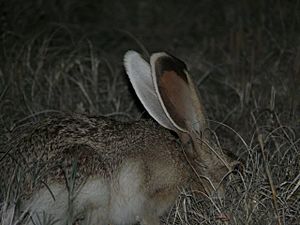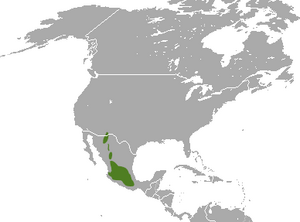White-sided jackrabbit facts for kids
Quick facts for kids White-sided jackrabbit |
|
|---|---|
 |
|
| Conservation status | |
| Scientific classification | |
| Genus: |
Lepus
|
| Species: |
callotis
|
 |
|
| White-sided jackrabbit range | |
The white-sided jackrabbit (Lepus callotis) is also called the Mexican hare. This animal is a type of jackrabbit. You can find it in a small area of North America. This area stretches from southern New Mexico into parts of northwestern and central Mexico. Sadly, this jackrabbit is considered threatened in New Mexico. Its numbers have been going down in recent years.
Contents
- Where White-Sided Jackrabbits Live (Habitat)
- What White-Sided Jackrabbits Look Like (Description)
- White-Sided Jackrabbit Life Cycle and Reproduction
- How White-Sided Jackrabbits Behave
- What White-Sided Jackrabbits Eat (Food)
- How Humans Affect White-Sided Jackrabbits
- Protecting White-Sided Jackrabbits (Conservation Efforts)
- Types of White-Sided Jackrabbits (Subspecies)
- See also
Where White-Sided Jackrabbits Live (Habitat)
The white-sided jackrabbit likes to live in high, flat areas called plateaus. This includes the grassy plains of southwestern New Mexico. It also lives in the open plains of southern Mexico. These jackrabbits prefer flat lands with lots of grass. They usually stay away from hills, mountains, trees, and shrubs.
What White-Sided Jackrabbits Look Like (Description)
White-sided jackrabbits are about 16 to 30 inches (41 to 76 cm) long. Their tails can be 1 to 4 inches (2.5 to 10 cm) long. Their front legs are 4 to 6 inches (10 to 15 cm) long. The back legs are longer, growing 6 to 12 inches (15 to 30 cm). Their ears can grow to be 2 to 6 inches (5 to 15 cm) long.
They have five toes on their front paws and four toes on their back paws. All their toes have strong claws. Female white-sided jackrabbits are usually a bit bigger than the males. This difference between males and females is called sexual dimorphism.
Their fur on their back is short and rough. It's a pale cinnamon color mixed with black. Their undersides are white. The tail is black on top and all white underneath. A special thing about them is their pure white sides, which is how they got their name! Their rump and thighs are also white with some black hairs.
In winter, their fur changes. It becomes iron gray on their back and hind legs. The front of their hind legs and tops of their feet turn white. Their head and back become dark pinkish-buff mixed with black. Their ears are dark, black, and white. The underside of their neck is dark grayish, and the rest of their underside is white.
White-Sided Jackrabbit Life Cycle and Reproduction
White-sided jackrabbits breed for at least 18 weeks. This happens from mid-April to mid-August. A female usually has about two young per litter. The young are born with soft, woolly fur. They grow up quickly and become able to breed fast. However, they don't start breeding in the first year after they are born.
How White-Sided Jackrabbits Behave
Most white-sided jackrabbit activity happens at night or during dusk. They are especially active on clear nights when the moon is bright. Clouds, rain, and wind can make them less active. However, the temperature doesn't seem to affect them much.
When they run away from danger, they flash their white sides. They make long, high leaps to escape. If a predator surprises them, they leap straight up. They stretch their back legs and flash their white sides. When resting, their fur helps them blend in with their surroundings. Their long back legs and feet help them run very fast in a zig-zag pattern. This helps them get away from animals chasing them.
Their long ears help them hear sounds. They also help them stay cool when it's hot. They can raise their ears like a fan to catch cool breezes. Their eyes are on the sides of their head. This gives them a full 360-degree view. This way, they can see danger coming from any direction.
A unique thing about white-sided jackrabbits is that they are often found in pairs. This is usually one male and one female. This pairing is most clear during breeding season. The male will protect his partner from other males. This pairing might help them stay together in areas where there aren't many jackrabbits. The two jackrabbits in a pair usually stay within 15 to 20 feet (4.5 to 6 meters) of each other. They run away together if someone approaches. This pair bond might even last during pregnancy.
White-sided jackrabbits build shelters. These shelters are about 15 inches (38 cm) long, 20 inches (51 cm) wide, and 7 to 8 inches (18 to 20 cm) deep. They usually make these shelters in clumps of tobosa grass. Sometimes, they might use underground shelters, but this is rare.
They eat by chewing and pulling grass blades from the ground. They might pull the whole plant up or just break off a piece. They eat the grass while sitting in a crouched position with their head raised. They don't use their front paws to eat, except to brace themselves. However, when eating certain nutgrass, they use their front paws to dig up the round roots.
White-sided jackrabbits make three types of sounds, which is a form of communication.
- When they are scared, they make a high-pitched scream.
- Males in a pair make harsh grunts if another male comes too close. They keep grunting until the other male leaves or is chased away.
- During a mating chase, they make a trilling grunt. It's not known which jackrabbit makes this sound.
What White-Sided Jackrabbits Eat (Food)
The white-sided jackrabbit mainly eats different types of grasses. These include buffalograss, tobosagrass, fiddleneck, wolftail, blue grama, vine mesquite, ring muhly, wooly Indian wheat, and Wright buckwheat. They also eat sedge nutgrass.
How Humans Affect White-Sided Jackrabbits
Many types of jackrabbits are seen as pests because they can damage farms. However, the white-sided jackrabbit is usually not considered a pest. It doesn't cause known harm to human property. Also, many jackrabbits are hunted for their meat and fur. This is not true for the white-sided jackrabbit. It is protected in most of the areas where it lives.
A study in 2011 found a main reason for the decline of white-sided jackrabbits in New Mexico. It was due to being hit by cars on roads at night. This often happened because of US Border Patrol traffic.
Protecting White-Sided Jackrabbits (Conservation Efforts)
The white-sided jackrabbit is considered endangered in Mexico. In New Mexico, it is listed as threatened. However, it does not have federal protection in the United States. A 2011 study in New Mexico estimated there were only about 45 of these jackrabbits left.
White-sided jackrabbits often live near farms. When too many farm animals graze in their habitat, it can be a problem. This overgrazing might be a reason for their decline. It might also be why the black-tailed jackrabbit (Lepus californicus) is replacing them. The black-tailed jackrabbit can adapt better to these habitat changes. Sadly, the chances for the white-sided jackrabbit to survive in many areas are not very good.
Types of White-Sided Jackrabbits (Subspecies)
There are two types, or subspecies, of the white-sided jackrabbit:
- L. c. callotis
- L. c. gaillardi
See also
 In Spanish: Liebre de flancos blancos para niños
In Spanish: Liebre de flancos blancos para niños


